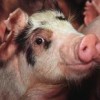 For the past six years, feed costs have continually increased and Florida has greater feed costs than the rest of the country because grain must be shipped here from where it was produced. But the Florida pork producers generally get prices above market value for their pigs because of strong demand for locally-raised foods. These Florida pork producers could become more profitable if they could significantly decrease their production costs. In Florida, pork producers have an opportunity to use citrus byproducts as a feedstuff to substantially and sustainably decrease their feed costs. This 4-page fact sheet was written by J. D. Crosswhite, N. B. Myers, A. T. Adesogan, J. H. Brendemuhl, D. D. Johnson, and C. C. Carr, and published by the UF Department of Animal Sciences, August 2012.
For the past six years, feed costs have continually increased and Florida has greater feed costs than the rest of the country because grain must be shipped here from where it was produced. But the Florida pork producers generally get prices above market value for their pigs because of strong demand for locally-raised foods. These Florida pork producers could become more profitable if they could significantly decrease their production costs. In Florida, pork producers have an opportunity to use citrus byproducts as a feedstuff to substantially and sustainably decrease their feed costs. This 4-page fact sheet was written by J. D. Crosswhite, N. B. Myers, A. T. Adesogan, J. H. Brendemuhl, D. D. Johnson, and C. C. Carr, and published by the UF Department of Animal Sciences, August 2012.
http://edis.ifas.ufl.edu/an282
Tag: Adegbola T. Adesogan
Annual Warm-Season Legumes for Florida and the US Gulf Coast: Forage Yield, Nutritional Composition, and Feeding Value (AN259)
High-quality forage legumes that can be grown during the warm-season are scarce in Florida and the Gulf Coast region. Seeded warm-season legumes, such as cowpea, soybean, and pigeonpea, are less expensive and faster to establish than perennial peanut, and they could provide nutritious forage to complement beef cattle and other ruminant animal feeding programs. This 5-page fact sheet summarizes the results of three years of field trials and two feeding trials conducted at North Florida Research and Education Center in Marianna, located in northwest Florida. Written by Jamie Foster, Robert Myer, A.T. Adesogan, Jeffery Carter, Lynn Sollenberger, and Ann Blount, and published by the UF Department of Animal Science, January 2011.
http://edis.ifas.ufl.edu/an259
AN255 The Annual Cultivated Peanut (Arachis hypogaea L.) as a Potential Forage Crop for Livestock in the Southeastern U.S.
AN255, a 5-page fact sheet by R. O. Myer, A. T. Adesogan, A. R. Blount, D. W. Gorbet, and B. L. Tillman, provides livestock producers with information on the use of annual cultivated peanut as a potential forage crop in the Southeast — forage production trial results, nutritional value, feeding value, and use as forage for grazing. Includes references. Published by the UF Department of Animal Sciences, December 2010.
http://edis.ifas.ufl.edu/an255
SSAGR177/AG180 Silage Harvesting, Storing, and Feeding
Revised! SS-AGR-177, an 8-page illustrated fact sheet by A. T. Adesogan and Y. C. Newman, discusses the advantages, disadvantages and phases of silage fermentation and the factors affecting silage quality. Published by the UF Department of Agronomy, September 2010.
http://edis.ifas.ufl.edu/ag180
SSAGR69/AA250 Silage Crops for Dairy and Beef Cattle
SS-AGR-69, a 9-page fact sheet by Y.C. Newman, A.T. Adesogan and J. Wasdin, provides information about forage crops that are grown or have been grown in Florida as high-energy or low-energy silages. Published by the UF Department of Agronomy, September 2009.
http://edis.ifas.ufl.edu/AA250
SSAGR93/AG161 Factors Affecting Forage Quality
Revised! SS-AGR-93, a 5-page illustrated fact sheet by A. T. Adesogan, L. E. Sollenberger, Y.C. Newman, and J.M.B. Vendramini, discusses forage quality and factors affecting intake and nutritive value. Includes references. Published by the UF Department of Agronomy, June 2009.
http://edis.ifas.ufl.edu/AG161
SSAGR322/AG332 Defining Forage Quality
SS-AGR-322, a 6-page illustrated fact sheet by Yoana C. Newman, Adegbola T. Adesogan, Joao Vendramini and Lynn Sollenberger, defines forage quality, changes in forage quality, and what information can be obtained from commercial laboratory analyses. Includes reference. Published by the UF Department of Agronomy, June 2009.
http://edis.ifas.ufl.edu/AG332